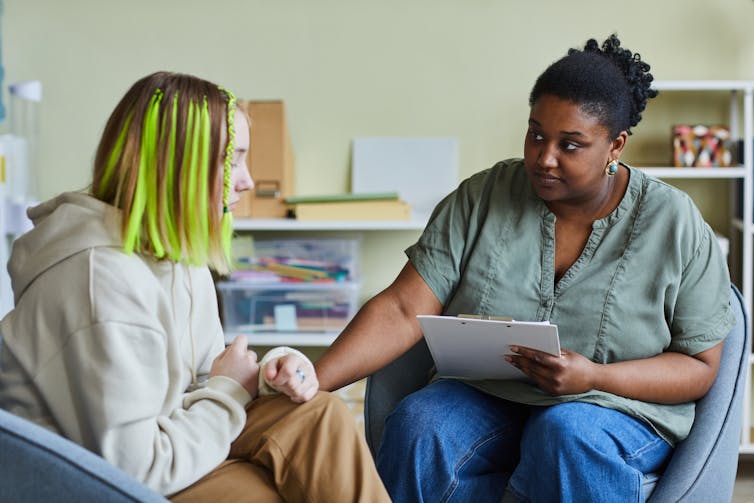A review into gender identity services for young people has said under-18s are being let down by the NHS. The final report of the Cass review describes a lack of long-term data and “remarkably weak” evidence on the effects of medical interventions in gender care.
However, medical transitioning, through hormone therapy or surgery, is only one route for transgender and gender non-conforming people of any age to explore their identity. Many will “socially transition” before or instead of medically transitioning. The report, alongside other research, recommends more long-term, robust research on both social transitioning and medical intervention.
Broadly speaking, social transitioning consists of actions or expressions that align with a chosen gender other than that assumed at birth. This can include changing one’s appearance through clothes and hairstyle, or choosing to use a different name or pronouns.
People may identify as agender, gender-fluid or non-binary, and may use gender neutral pronouns such as they/them, or those that have arisen specifically for this purpose like ze/zir. Or, if people feel that they were assigned the wrong identity at birth they may wish to identify as transgender.
Social transitioning, as the report notes, usually occurs at home or in schools or workplaces, not in medical establishments. For young people exploring their gender identity, this makes schools a particularly important environment.
Existing research suggests that social transitioning in early adolescence itself is not harmful, but an unsupportive environment where gender-diverse young people feel “othered” or are subject to bullying can lead to long-term, negative wellbeing. Another study of trans UK adults identified a supportive environment for social transition as a key factor in decreasing suicidal thoughts.
Social transitioning is also an important first step in obtaining a gender recognition certificate (GRC). If someone wants to be legally recognised as their acquired gender, they must provide evidence of a change of name or title, or change of gender marker for at least two years.
A GRC cannot be obtained under the age of 18. The process does not require any medical interventions. For young people to obtain a GRC at 18, they must have socially transitioned and be recognised by another name or pronoun from at least age 16.

The role of schools and teachers
There is no question that educational institutions should foster positive, affirming environments for young people. What does this mean when it comes to gender exploration?
The review chair, retired consultant paediatrician Dr Hilary Cass, noted that rigid binary gender stereotypes can be unhelpful for young people, and that exploration of gender is a normal process. In my research, I have interviewed teachers navigating interactions between schools, students and their parents regarding this exploration.
Citing their duty of care, teachers expressed a need for clear guidelines from the government on how to best support students who are socially transitioning.
To this end, the government has recently closed a consultation on guidance for schools on gender questioning children. The draft guidance encourages parental consent if a child wants to change their name or pronoun.
However, teachers I interviewed expressed concern that, in some cases, telling parents about a student’s social transitioning could lead to safeguarding risks. This disclosure, they said, would not be expected of teachers if the student was disclosing their sexuality.
Read more: Trans guidance for schools: the voices of young people are missing
The teachers I interviewed placed student welfare at the heart of their concerns. Some discussed safeguarding incidents where students were made homeless due to parents’ disapproval of their child’s gender identity or expression. Ultimately, they want students to feel safe, heard and have autonomy over their gender expression in school.
Teachers were concerned that existing school policies were based on the subjective beliefs of school leaders, rather than student wellbeing. Those I interviewed highlighted contradictions in how their schools treated gender-diverse students.
For example, many students prefer to be called by a shortened name or middle name rather than the name on their birth certificate. These name changes were never challenged. However, if a student presented as gender-diverse, a different approach was imposed by head teachers.
Above all, the teachers I spoke to in my research want schools to be a place where students feel acknowledged, safe, empowered and supported, whether they are navigating their sexuality or gender expression.

